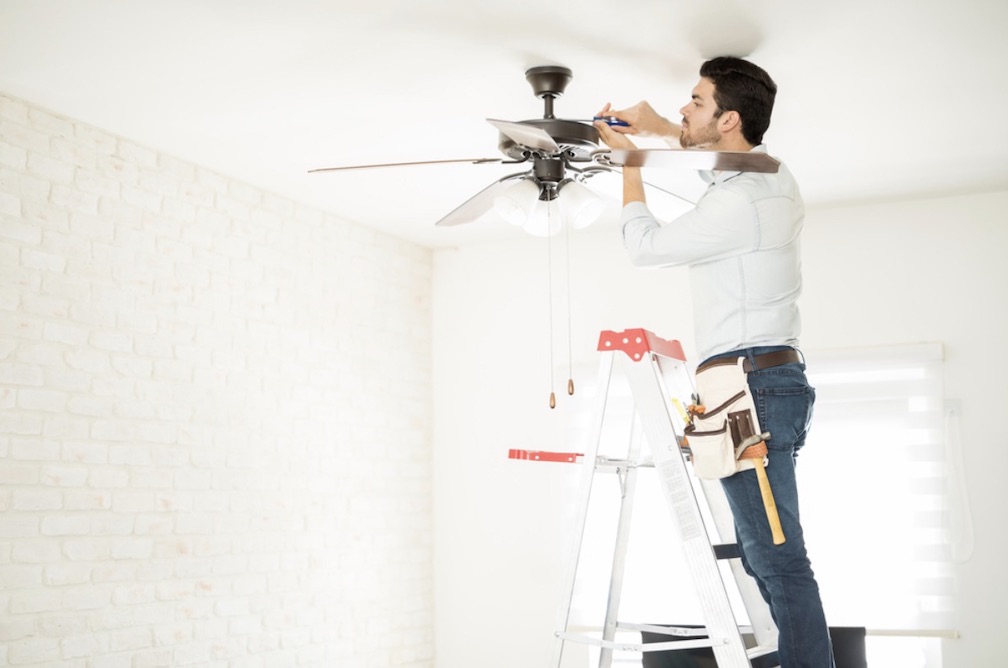How Much Does Ceiling Fan Installation Cost In 2023?

Ceiling fans are the best way to keep your homes and businesses cool. The time is ripe for a ceiling fan swap if your existing one is wobbly or incoherent with the aesthetic of your space. It is also possible that your property is new and requires a means of airflow. You can request an electrician to install a fan on plasterboard, coffered, exposed beam ceilings, and more. The total cost of ceiling fan installation is typically a composite of the unit price, the number of fans to install, base labour charges, and additional costs due to special requirements.
Take the time to acquaint yourself with ceiling fan installation cost in Australia and then only dial an electrical service provider company.
How Do You Calculate the Cost of Ceiling Fan Installation?
Cost of the Fan
The cost of your fan hinges on the brand, blade diameter, motor durability, and materials.
Standard Fans
A standard fan has 4–5 blades. It may or may not come with an attached light. They are generally made of bronze or nickel. Purchasing such a model would cost anywhere between $100 and $300.
Low-Profile Fans
Low-profile fans have drop lengths under 30 cm. They are the right investment if your floor-to-ceiling length is below 2.4 m. Given its proximity to the ceiling, this fan hits two targets with one stone: safety and space. One unit can cost between $200 to $500.
Outdoor Fans
Outdoor fans are ideal for porches and exposed spaces. Because of their moisture-resistant motors and warp-resistant blades, you can count on them to withstand rain and humidity. These weatherproof models have a price range of $300 to $800.
Dual Motor Fans
Double-motor fans have two heads affixed to the same base. As they spin at high speeds, they produce a powerful breeze, making them an excellent choice for large rooms. You can expect to spend $400 to $1,000 for a double-headed fan.
Commercial Fans
Commercial fans ensure consistent and powerful airflow in locations like factories, warehouses, and industrial kitchens. Their high-velocity airflow and durable motors keep the work environment well-ventilated with little to no sound. The starting price of an industrial fan is roughly $4,000.
Energy Star Fans
Fans with an Energy Star Certification are best for environmentally and cost-conscious homes and businesses. These models are 60% more efficient than their regular counterparts. Their aerodynamic design and powerful motors enable superior air circulation without high voltage requirements. Purchasing one of these units would require a budget of $80 to $700.
Service Charges
Tradesperson
The average base charge of the electrician is $75 an hour. Here are some factors that could bump up their charges:
Experience. Electricians with 5+ years of experience could charge higher service fees than younger and newer workers.
Qualifications. Tradespeople with a Certificate III in Electrotechnology, a valid electrician’s licence, and relevant industry credentials like those from the Australian Institute of Electrical and Electronic Engineers (AIEE) might work for higher prices.
Location. There is usually a high concentration of available electricians in Sydney and the other areas like Brisbane, Melbourne, Perth, Adelaide, Darwin, and Canberra. Companies will do their best to match you with a professional in your vicinity, but if that is not possible, they will allocate the task to the nearest electrician and tack on a small distance fee.
Work duration. A standard ceiling fan installation takes around 45–60 minutes, depending on the type of fan and the ease of installation. You will incur additional costs if your fan or your property has special, time-consuming requirements.
Installation Scenario
The nature of the installation will influence the ceiling fan installation cost. Here are some scenarios:
Fan replacing another fan. Replacing your existing fan with a new one will work out cheaper than the other scenarios because the installation infrastructure is already in place.
Fan replacing a light. Replacing your light fixture with a fan is marginally more expensive because the electrician will have to adapt the space and circuitry for a fan.
New installation. Installing a fan in a fresh spot will require considerable manual work, rendering this scenario more expensive.
Mixed. If you need multiple fans installed at differently outfitted points of the property, the electrician will assess the scenario and calculate the fee.
Number of Fans
You can maximise your savings on ceiling fan installation with quantity discounts. Bulk pricing is a boon, especially if you are conducting mass replacements or installations. The specifics vary across businesses, but many commonly slash 15–25% of the price for two fans and up to 30% for three fans. For 4+ fans and mixed requirements, they will e-mail you a personalised quote.
Fan Type
Fans from certain brands might have special installation requirements due to their sophistication. The blade size and weight of the model will also impact its manoeuvrability. Additionally, if your unit is a fan-light combo, comes with a remote control, or requires a wall switch, you can expect the installation charges to be steeper.
Property Features
Ceiling fan installation cost is also contingent on property features including, but not limited to:
Ceiling height. The electrician will use an extension rod for ceilings higher than 4 m to install the fan.
Roof beams. Fans require a suitable suspension point. Roofs without joists impose extra labour.
Electrical compliance. If the wiring and switchboard are outdated or incompatible (especially in properties older than 10 years), the electrician must update the system and obtain a compliance certificate.
Conclusion
Ceiling fans are convenient and cost-effective appliances that keep your space ventilated. Running your ceiling fan costs only $0.02 to $0.05 an hour in electricity bills. In other words, excellent savings. Seek out an electrical company with a positive reputation and engage them for your ceiling fan installation.


